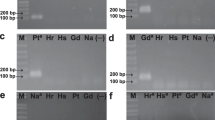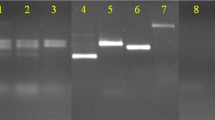Abstract
A PCR-based method for the quantitative detection of Lentinus edodes and Trametes versicolor, two ligninolytic fungi applied for wastewater treatment and bioremediation, was developed. Genomic DNA was used to optimize a PCR method targeting the conserved copper-binding sequence of laccase genes. The method allowed the quantitative detection and differentiation of these fungi in single and defined-mixed cultures after fractionation of the PCR products by electrophoresis in agarose gels. Amplified products of about 150 bp for L. edodes, and about 200 bp for T. versicolor were purified and cloned. The PCR method showed a linear detection response in the 1.0 μg–1 ng range. The same method was tested with genomic DNA from a third fungus (Phanerochaete chrysosporium), yielding a fragment of about 400 bp. Southern-blot and DNA sequence analysis indicated that a specific PCR product was amplified from each genome, and that these corresponded to sequences of laccase genes. This PCR protocol permits the detection and differentiation of three ligninolytic fungi by amplifying DNA fragments of different sizes using a single pair of primers, without further enzymatic restriction of the PCR products. This method has potential use in the monitoring, evaluation, and improvement of fungal cultures used in wastewater treatment processes.





Similar content being viewed by others
References
Adair S, Kim SH, Breuil C (2002) A molecular approach for early monitoring of decay basidiomycetes in wood chips. FEMS Microbiol Lett 211:117–122
Altschul SF, Madden TL, Schäffer AA, Zhang J, Zhang Z, Miller W, Lipman DJ (1997) Gapped BLAST and PSI-BLAST: a new generation of protein database search programs. Nucleic Acids Res 25:3389–3402
Ashktorab H, Cohen RJ (1992) Facile isolation of genomic DNA from filamentous fungi. Biotechniques 13:198–200
Bogan BW, Lamar R (1996) Polycyclic aromatic hydrocarbon-degrading capabilities of Phanerochaete laevis HHB-1625 and its extracellular ligninolytic enzymes. Appl Environ Microbiol 62:1597–1603
Brown AE, Muthumeenakshi S, Sreenivasaprasad S, Mills PR, Swinburne TR (1993) A PCR primer-specific to Cylindrocarpon heteronema for detection of the pathogen in apple wood. FEMS Microbiol Lett 108:117–120
Cano-Ramirez C (2001) Quantitative detection of fungi Trametes versicolor and Lentinus edodes in defined mixed culture using a PCR method. B.Sc. Thesis. Universidad Autónoma Metropolitana-Xochimilco, Depto. del Hombre y su Ambiente. México DF, Mexico
Challen MP, Andrew JM, Daniel MC (1995) Facile extraction and purification of filamentous fungal DNA. Biotechniques 18:975–977
D’Souza TM, Boominathan K, Reddy CA (1996) Isolation of laccase gene specific sequences from white rot and brown rot fungi by PCR. Appl Environ Microbiol 62:3739–3744
Das A (1990) Overproduction of protein in Escherichia coli: vectors, hosts and strategies. In: Deutscher MP (ed) Methods in enzymology: guide to protein purification. Academic Press, San Diego, pp 93–112
De la Rubia T, Ruiz E, Perez J, Martinez J (2002) Properties of a laccase produced by Phanerochaete flavido-alba induced by vanillin. Arch Microbiol 179:70–73
Estrada-Vázquez C, Poggi-Varaldo HM, Hernández-Vera R, Fernández-Villagómez G, Magaña-Plaza I, Hernández-González A (1998) Biological post-treatment of an anaerobically-treated black liquor spills wastewater from Kraft pulp mills. In: Alleman JE, Blatchley ER, Hua I, Jacko RB, Javfert CT, Nies L (eds) 52nd Purdue industrial waste conference . Ann Arbor Sci, Chelsea, Mich., pp 493–503
Gardes M, Bruns TD (1993) ITS primers with enhanced specificity for basidiomycetes application to the identification of mycorrhizae and rusts. Mol Ecol 2:113–118
Jasalavich CA, Ostrofsky A, Jellison J (2000) Detection and identification of decay fungi in spruce wood by restriction fragment length polymorphism analysis of amplified genes encoding rRNA. Appl Environ Microbiol 66:4725–4734
Johnston CG, Aust SD (1994) Detection of Phanerochaete chrysosporium in soil by PCR and restriction enzyme analysis. Appl Environ Microbiol 60:2350–2354
Kreuzinger N, Podeu R, Gruber F, Gobl F, Kubicek CP (1996) Identification of some ectomycorrhizal basidiomycetes by PCR amplification of their gpd (glyceraldehyde-3-phosphate dehydrogenase) genes. Appl Environ Microbiol 62:3432–3438
Larena I, Salazar O, Gonzalez V, Julian MC, Rubio V (1999) Design of a primer for ribosomal DNA internal transcribed spacer with enhanced specificity for ascomycetes. J Biotechnol 75:187–194
Lecomte P, Peros JP, Blancard D, Bastien N, Delye C (2000) PCR assays that identify the grapevine dieback fungus Eutypa lata. Appl Environ Microbiol 66:4475–4480
Leonowicz A, Matuszewska A, Luterek J, Ziegenhagen D, Wojtas-Wasilewska M, Cho NS, Hofrichter M, Rogalski J (1999) Biodegradation of lignin by white rot fungi. Fungal Genet Biol 27:175–185
Lund AH, Duch M, Pedersen FS (1996) Increased cloning efficiency by temperature-cycle ligation. Nucleic Acids Res 24:800–801
Mayer AM, Staples RC (2002) Laccase: new functions for an old enzyme. Phytochemistry 60:551–565
Mougin C, Boyer FD, Caminade E, Rama R (2000) Cleavage of the diketonitrile derivative of the herbicide isoxaflutole by extracellular fungal oxidases. J Agric Food Chem 48:4529–4534
Nugent KG, Saville BJ (2004) Forensic analysis of hallucinogenic fungi: a DNA-based approach. Forensic Sci Int 140:147–157
Ortega-Clemente LA, Estrada-Vázquez C, Esparza-García F, Caffarel-Méndez S, Rinderknecht-Seijas N, Poggi-Varaldo HM (2004) Integrated biological treatment of recalcitrant effluents from pulp mills. Water Sci Technol 50:145–156
Poggi-Varaldo HM (1994) Pollution prevention and wastewater treatment in the pulp and paper industry. Water Wastewater Int 9:12–18
Poggi-Varaldo HM (1995) Anaerobic methanogenic consortia for pre-treatment and detoxification of pulp and paper mill wastewaters. In: Poggi-Varaldo HM, Rodríguez-Vázquez R (eds) Proceedings of the 1st International Meeting on Microbial Ecology. Editorial Facultad de Química UNAM, CONACyT Mexico DF, Mexico, pp 53–54
Ramirez-Canseco S, Poggi-Varaldo HM, Rodríguez-Vázquez R, Estrada-Vázquez C, Rinderknecht-Seijas N (2000) Fungal post-treatment of an anaerobically-treated black liquor-contaminated effluent from a Kraft pulp mill. In: Foresti E, Chemicharo CAL, Kato MT, Florencio L, Santos de Lima E (eds) Proceedings of the 6th Latin American workshop and seminar on anaerobic digestion, vol 2. Recife, Pernambuco. 5–9 September 2000. Editora Universitaria da UFPE, Recife, Pernambuco, pp 191–195
Regalado V, Perestelo F, Rodríguez A, Carnicero A, Sosa FJ, De la Fuente G, Falcón MA (1999) Activated oxygen species and two extracellular enzymes: laccase and aryl-alcohol oxidase, novel for the lignin-degrading fungus Fusarium proliferatum. Appl Microbiol Biotechnol 51:388–390
Robles A, Lucas R, Alvarez-de-Cienfuegos G, Gálvez A (2000) Phenol-oxidase (laccase) activity in strains of the hyphomycete Chalara paradoxa isolated from olive mill wastewater disposal ponds. Enzyme Microb Technol 26:484–490
Stuardo M, Vasquez M, Vicuna R, Gonzalez B (2004) Molecular approach for analysis of model fungal genes encoding ligninolytic peroxidases in wood-decaying soil systems. Lett Appl Microbiol 38:43–49
Woodcock DM, Crowther PJ, Doherty J, Jefferson S, DeCruz E, Noyer-Weidner M, Smith SS, Michael MZ, Graham MW (1989) Quantitative evaluation of Escherichia coli host strains for tolerance to cytosine methylation in plasmid and phage recombinants. Nucleic Acids Res 17:3469–3478
Zhao J, Kwan HS (1999) Characterization, molecular cloning and differential expression analysis of laccase genes from the edible mushroom Lentinula edodes. Appl Environ Microbiol 65:4908–4913
Acknowledgements
The work described in this paper was partially supported by CINVESTAV-IPN, Accesolab México, BioRad México, and Kirkegaard & Perry Laboratories, USA. We thank Maria Guadalupe Aguilar-Gonzalez from the DNA Sequencing Unit (Departamento de Genética y Biología Molecular) and Carolina Miranda-Brito (Departamento de Fisiología, Biofísica y Neurociencias) for technical assistance, Daniel Castro-Roa for critical review of the manuscript, and Rosa Maria Cruces for clerical assistance. We wish to thank Dr. Ian Reid, formerly with PAPRICAN, Canada, for the kind donation of the strain of Trametes versicolor to one of the authors (H.M.P.-V.).
Author information
Authors and Affiliations
Corresponding author
Rights and permissions
About this article
Cite this article
García-Mena, J., Cano-Ramirez, C., Garibay-Orijel, C. et al. A PCR method for the detection and differentiation of Lentinus edodes and Trametes versicolor in defined-mixed cultures used for wastewater treatment. Appl Microbiol Biotechnol 67, 524–531 (2005). https://doi.org/10.1007/s00253-004-1795-z
Received:
Revised:
Accepted:
Published:
Issue Date:
DOI: https://doi.org/10.1007/s00253-004-1795-z




